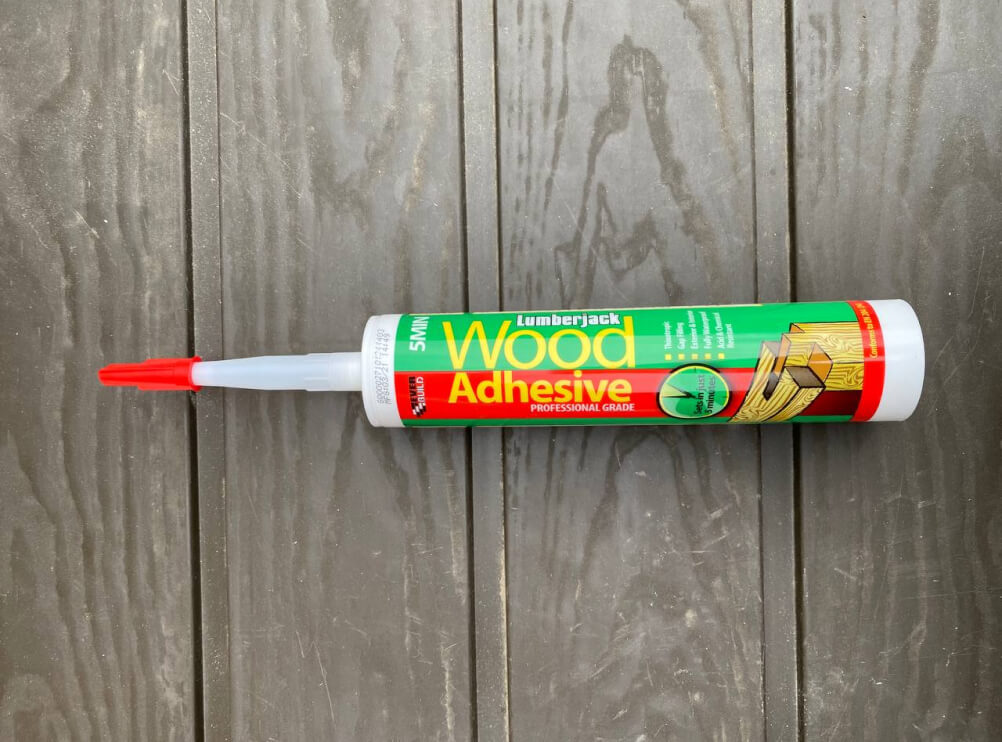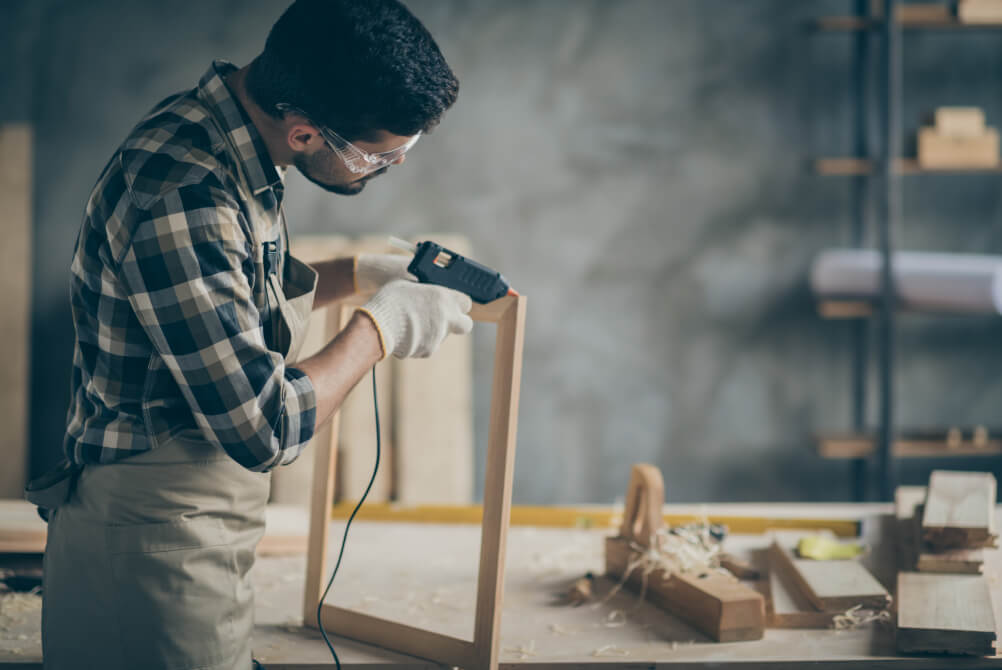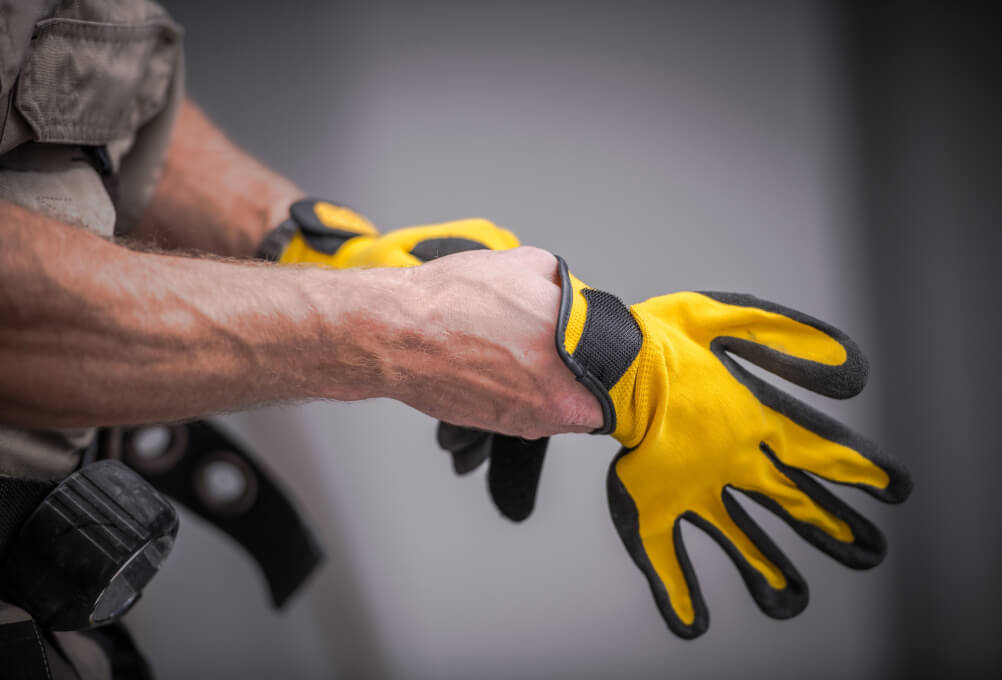Whether you do DIY or woodworking, wood glues are an extremely important part of both. Having good-quality wood glue that lasts a long time can help make a DIY project a success.
However, there are loads of wood glues on the market, so how do you choose the best wood glue to use? Well, that depends on your woodwork or DIY project.
Below, we have the best wood glues available in the UK right now, but first, let’s look at different types of wood glue to see which ones you should be using.

Knowing which types of glue there are, means that you can choose the right glue for your woodworking projects. Some wood glues act quickly, while others have longer cure times. Choosing the right wood glue for your project can really make the difference between a strong bond and a failed glue joint. Here’s a breakdown of wood glues to help you choose the best for your next DIY project.
PVA glue is what most of us think of as standard wood glue. It is the glue most commonly used to join two pieces of wood together, and it has the longest storage life among other wood glues. It provides one of the strongest bonds in woodworking as it soaks into the wood and bonds it very securely. In fact, PVA is so strong that you’re more likely to break the wood than the glue joint.

This universal wood glue can be used for just about any joint you are likely to make during your DIY career. It has a working time of between 5-20 minutes and sets up in about 24 hours, but this can vary between companies. If you do any DIY or woodworking, having a bottle of PVA glue is an absolute must.
Polyurethane glue foams up and penetrates deep into the wood. This glue is ideal if you are making end grain connections in your joints. The glue can get into the grain of the wood and create a very tight, strong bond. While polyurethane glue is very good glue, there is a learning curve, and it is not the best glue for every job.
Otherwise known as super glue, CA glue offers a quick-drying solution to a lot of problems in woodworking. A lot of people use super glue to clamp up a joint while other glues dry. For example, you can spread PVA wood glue in a wood joint and add a few daps of CA glue in the joint too. The CA glue will dry almost instantly and hold the joint together while the PVA glue sets.
There are a host of uses for CA glue in woodworking and DIY. It offers a strong bond, but it can be fragile over time, so we wouldn’t recommend using CA glue for any joint as a permanent fix, but for quick bonds, while other glues are drying, it is a real timesaver.
Epoxy is interesting wood glue, as it is used in so many creative ways within woodworking and DIY. To start with, epoxy is the best glue for filling cracks and gaps in the wood. It can also be used when longer assembly times are needed as it has a much longer working time than most other glue. Once set, though, epoxy has an extremely strong bond. As long as the glue surfaces are clean and free from dust, an epoxy joint is never going to fail.

Epoxy is also used in wood turning, river tables and a great deal more. It is extremely versatile wood glue, and there’s a huge variety of epoxies available. Choosing the right epoxy for your project is key to getting the results you want.
Hide glue has been used for thousands of years. It is made from the hide of animals and creates an extremely strong bond. Hide glue has a long open time as well, so many people choose to use this wood glue when they have a lot of joints that must come together at the same time.
While hide glue does offer a stronger bond than some other glues, it can also be undone. If a joint fails, or there is a gap in a joint you are not happy with, some heat can open up the joint enough to sort it out. You can buy genuine hide glue in a crystal form that you mix together yourself, but it is also available in pre-mixed solutions. It is getting trickier to find genuine hide glue, but some companies do still make it.
Everbuild 502 is quickly becoming one of the most popular wood glue in the UK. It is highly versatile as it is a waterproof glue and can be used in all exterior and interior projects. It is also a resin-based white glue. This means it penetrates deep into the wood grain and offers a strong and durable bond.
Clean up with this wood glue is really easy; a damp paper towel is all you need. Plus, it sets up quickly, with a 5-minute working time. It does take 24 hours to fully cure, but you can start working on your project again in about an hour. This PVA glue is a must for any DIY or woodworking project.
Anyone with a few woodworking projects under their belt knows that having some superglue in their toolkit is really handy. Whether you are after a temporary hold or a near-permanent one, superglue can be your best friend.
Mitrebond makes some of the best super glue in the UK, and this one comes with an activator, so it sets in seconds. You can use this superglue in loads of applications in any DIY or woodworking project or even while restoring sash windows, and it is just as valuable as the PVA above.
Gorilla wood glue is some of the strongest wood glue in the world, and for many woodworkers, it is the only wood glue they trust. This PVA glue sets up in 20-30 minutes, depending on the temperature, and offers an almost permanent bond for any wood joint.
This can be used inside or outside, and it dries clear. If you have any outdoor projects coming up, Gorilla wood glue will be your best friend. It is really easy to work with; it spreads nicely and cleans up easily. It can also be used on just about any wood you can buy too, so it is well worth having a bottle of this glue in your tool kit.
When it comes to the strongest wood glue, the choice can vary based on the type of wood, the joint, and the specific project requirements. Generally, PVA glue is considered one of the strongest and most reliable options. It penetrates deep into the wood grain, creating a bond that is often stronger than the wood itself. However, epoxy glue is also a top contender due to its exceptional durability and versatility.
Epoxy glue, particularly, is known for filling gaps and providing a long-lasting, strong bond. It is widely used in both woodworking and DIY projects for its ability to withstand stress and environmental factors once cured. This makes it ideal for applications requiring robust and permanent joints.
According to a user discussion on Reddit,
“Gorilla Glue and Titebond are both great for different reasons. Gorilla Glue expands and fills gaps, which is useful for rougher joints, while Titebond offers a very strong, fast-setting bond that’s great for clean, precise work”
(source). This user insight highlights the practical applications and strengths of both types of glue, emphasizing their effectiveness in different scenarios.
Alex, an industry expert at The Chameleon Decorators, adds,
“In my professional experience, epoxy wood glues are unparalleled in terms of strength and versatility. They not only provide an extremely strong bond but are also highly resistant to environmental stressors. For critical repairs and projects that demand longevity, epoxy glue is the go-to choice.”
Choosing the best wood glue for your project greatly depends on the project, how durable it needs to be, the wood you are using, whether it is inside or outside, cure time and dry time and a great deal more. Here are some considerations about wood glue to make when choosing the right one for your project.

The adhesive strength of glues for wood does vary. You may want to temporarily glue two pieces of wood together or bond them permanently; there are glues for both.
Alex, an industry expert at The Chameleon Decorators, notes,
“When working with critical joints in woodworking, choosing a glue with high adhesive strength, such as epoxy or polyurethane, ensures the longevity and integrity of the project.”.
Many types of glue, like CA and epoxy, are available in different viscosities. Depending on your needs, you can choose a thin glue to get into cracks and fill them or a thicker glue that won’t penetrate as far into the wood.
Some glues can be stored for years and years, like hiding glue in crystal form, for example. Other glues, like some PVAs, have a shelf-life of about six months. Epoxies can be stored for a very long time, as can CA glue, unless it is opened. Most glues state how long they can be stored on the bottle, but hot and cold weather can also affect glue. Once a glue goes past its shelf-life date, it won’t provide as strong a glue joint as it once did. It is well worth buying smaller amounts of glue so that you aren’t wasting it by having to throw it away all the time.
CA glue can dry in seconds, while glues like PVA and epoxy take 24 hours to cure and up to a week to fully cure. Just because CA glue dries quickly, it doesn’t mean it is the right glue for every woodworking project. Sometimes you need to use the longer curing glues to ensure your joints are the strongest they can be.
The colour of the wood glue can affect the final appearance of your project. For example, some glues dry clear, while others may have a yellowish tint. It’s important to choose a glue that either matches the wood colour or can be easily painted or stained over.
By considering adhesive strength, dry time, shelf life, colour, and viscosity, you can select the best wood glue for your specific project needs. Understanding these factors helps ensure your woodworking projects are durable, aesthetically pleasing, and successful.
The effectiveness of even the best wood glue depends on the cleanliness and smoothness of the surface. Dust and contaminants can reduce the glue’s adhesion, so ensuring a clean surface is crucial. Before applying glue, sand the wood lightly and remove any dust with a damp cloth.
Applying glue evenly is essential to avoid weak spots in the bond. A brush or roller can help distribute the glue uniformly and prevent excessive application, which can be challenging to clean. Make sure to cover the entire surface to be joined.
Successful gluing hinges on correct clamping. This involves applying the appropriate pressure to hold the glued surfaces together. Too much pressure can squeeze out excess glue, while insufficient pressure may result in a weak bond. Clamping for at least 30 minutes to an hour is recommended for most glues.
Any glue that oozes out of the joint should be wiped away promptly with a damp cloth or sponge. This step is important not only for aesthetics but also to prevent issues with the wood’s finish. Removing excess glue before it dries makes sanding and finishing easier.
Patience is key during the drying and curing process, even for the strongest wood glue. Rushing this stage can compromise the strength of the bond. Adhere to the recommended drying and curing times for the best results. For instance, PVA glue typically requires 24 hours to fully cure.
Different wood glues perform optimally under specific environmental conditions. When purchasing glue, consider the working environment to ensure the best performance and to avoid wasting resources or leaving a project incomplete. For example, some glues may not cure properly in cold or humid conditions.
Ever had super glue in your eye? Well, if you haven’t, I can say it sucks. You see, super glue doesn’t dry in your eye. Instead, it sits on the surface of the water in your eye. The moment you close your eye, though, it seals it shut. So, when you get super glue in your eye, you must keep it open and wash your eyes thoroughly. Before doing anything with super glue, just stick some eye protection on; you’ll be really glad you did!

This isn’t really a safety tip; this is a hobby woodworker speaking from experience. If you have a complex glue-up to do, it is well worth doing a dry run without any glue. It allows you to get your clamps in place, the screws lined up correctly and know where things might go wrong during the glue-up without needing to hurry before the glue sets up.
Once you’ve got your clamps, screws and mind ready, add the glue and get everything glued up securely.
It depends on the glue. CA glue, for example, has a drying time of a few seconds, while epoxy and PVA have a cure time of 24 hours and sometimes even longer to fully cure. We know long wait times for wood glue aren’t ideal, but in general, the longer you need to wait for the glue to dry, the stronger the glue joint will be.
You’ll usually find that wood glue will last around about six months. So, if you don’t do a lot of DIY, don’t buy a huge bottle of wood glue. CA glue can last a long time, but once open, it will get thicker as it is exposed to air.
In terms of how long wood glue lasts in a joint, there are many examples of wooden furniture with glue joints that have lasted for hundreds of years. If the joint is very strong, your project will probably outlive you.
It is well worth investing in some clamps to ensure your glue joints are as secure as possible. If you intend to use screws, you can avoid clamps, though if you are using screws, pre-drill and fix the screws in place before you add glue. Remove the screws and then add glue; this makes lining the pieces of wood up much easier. Ensure that there is plenty of glue in the joint, and secure the screws in place. You can remove excess wood glue with a damp paper towel.
The most commonly used wood glue nowadays is PVA glue, but it isn’t the PVA glue that we used in art class or that our kids use now. It is thicker and designed to be used for wood.
The easiest way to remove excess glue on wood is to use a damp paper towel. You can also use a drinking straw to reach into tighter areas.
For most wood glues, clamping for at least 30 minutes to an hour is recommended to ensure a strong initial bond. However, some glues like PVA may require clamping for up to 24 hours for full curing. Always refer to the specific glue’s instructions for the best results.
Wood glue can be stronger than screws in many cases, as it creates a continuous bond across the joint, distributing stress more evenly. While screws provide mechanical fastening, wood glue penetrates the wood fibres, creating a bond that is often stronger than the wood itself. For maximum strength, a combination of both glue and screws can be used.